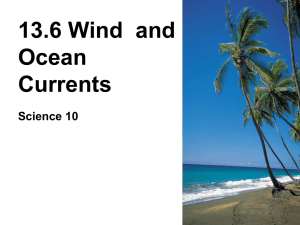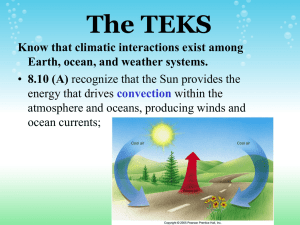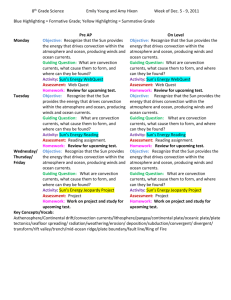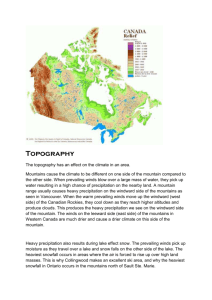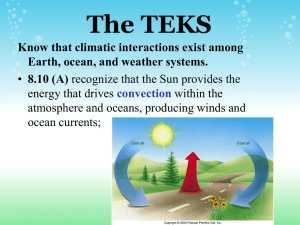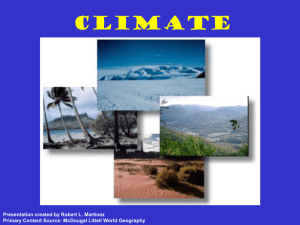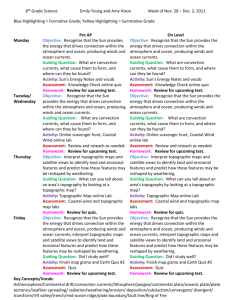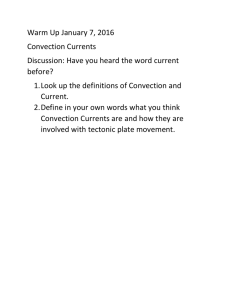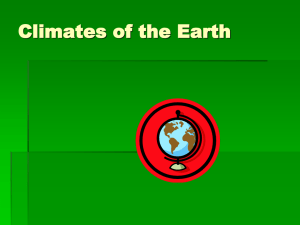Currents Powerpoint - Mr. Wieners 8th Grade Science
advertisement
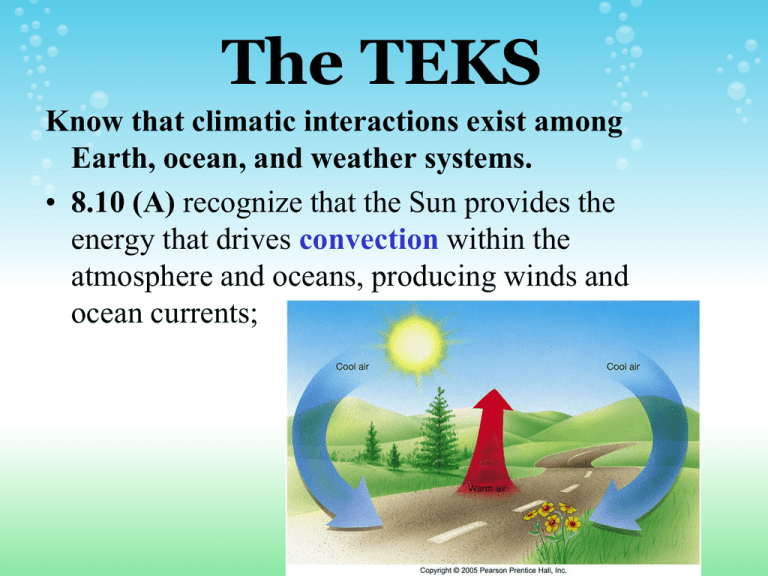
The TEKS Know that climatic interactions exist among Earth, ocean, and weather systems. • 8.10 (A) recognize that the Sun provides the energy that drives convection within the atmosphere and oceans, producing winds and ocean currents; CONVECTION Transfer of heat by the movement of warmed fluid (air or liquid) Warm fluid rises (less dense) Cool fluid sinks (more dense) CONVECTION CONVECTION CONVECTION Moves air in the atmosphere! Moving Air = Winds Convection in the atmosphere is the main cause of the wind. Where does the Energy for Convection come from on Earth? THE SUN!!! CONVECTION CONVECTION causes deep ocean currents! CONVECTION Wind over the shore changes direction because of EARTH’S UNEVEN WARMING & COOLING! Hot Air is Less Dense! Atmospheric Density How high is the atmosphere? 99% is within 30 km / 18 miles of the surface of the Earth Half the atmosphere is 5 km / 3.5 miles above the surface of the Earth Air Pressure – the weight of the air pressing on the surface at a give location What is most dense SINKS! Atmospheric Movement MOSTLY CAUSED BY: - Temperature differences - Pressure differences - Coriolis Effect (due to Earth’s rotation) Air Movement Gas molecules move from high density to lower density The TEKS Know that climatic interactions exist among Earth, ocean, and weather systems. • 8.10 (B) identify how global patterns of atmospheric movement influence local weather using weather maps that show high and low pressures and fronts; We would expect… Coriolis Effect breaks up Global Circulation • On Earth the large circulation cell breaks up into 3 smaller ones, moving diagonally • Other worlds have more or fewer circulation cells depending on their rotation rate The Coriolis effect • The Coriolis effect – Is a result of Earth’s rotation – Causes moving objects to follow curved paths: • In Northern Hemisphere, curvature is to right • In Southern Hemisphere, curvature is to left – Changes with latitude: • No Coriolis effect at Equator • Maximum Coriolis effect at poles The Coriolis effect on Earth • As Earth rotates, different latitudes travel at different speeds • The change in speed with latitude causes the Coriolis effect Figure 6-9a Global Winds - winds that blow steadily in paths for thousands of kilometers Total Atmosphere Circulation Role of the Ocean • Slowly absorbs and slowly releases heat energy helping keep Earth’s temperatures relatively stable • Oceans heat or cool the air above them and transport heat around the globe in currents. • Hurricanes form over warm ocean water, drawing their energy from the water’s heat. Ocean Currents Currents • large scale water movements – occur everywhere in ocean – both surface and deep • 2 main types: surface currents (10%) and subsurface currents (90%) – surface currents are primarily wind driven – deep currents are density driven – other forces affecting currents Coriolis effect friction gravity thermal expansion geologic shape of ocean basin Major oceanic circulation systems Current Gyres Gyres are large circular-moving loops of water Five main gyres (one in each ocean basin): • North Pacific • South Pacific • North Atlantic • South Atlantic • Indian • Generally 4 currents in each gyre • Centered about 30o north or south latitude Wind-driven surface currents Lost at Sea Duckie Progress •January 1992 - shipwrecked in the Pacific Ocean, off the coast of China •November 1992 - half had drifted north to the Bering Sea and Alaska; the other half went south to Indonesia and Australia •1995 to 2000 - spent five years in the Arctic ice floes, slowly working their way through the glaciers •2001 - the duckies bobbed over the place where the Titanic had sunk •2003 - they were predicted to begin washing up onshore in New England, but only one was spotted in Maine •2007 - a couple duckies and frogs were found on the beaches of Scotland and southwest England. Other Effects of Wind on Water Movement Downwelling –a wind-driven surface current collides with a land mass, forces the surface water into the deep ocean bringing dissolved oxygen from the surface to the deep. two surface currents colliding surface current colliding with land mass Upwelling - when a wind-driven surface current moves away from a land mass, pulls deep ocean water to the surface bring nutrients from the deep ocean to the surface. two surface currents pushed in opposite directions surface current pushed away from land mass Surface and Deep-Sea Current Interactions Unifying concept: “Global Ocean Conveyor Belt” http://seis.natsci.csulb.edu/rbehl/ConvBelt.htm Atmospheric Movement MOSTLY CAUSED BY: - Temperature differences - Pressure differences - Coriolis Effect (due to Earth’s rotation) Global Winds - winds that blow steadily in paths for thousands of kilometers Types of Global Winds • Polar Easterlies -Formed from cold sinking air moving from the poles creating cold temperatures, extend from the poles to 60° latitude • Westerlies - Flow towards the poles from west to east carrying moist air over the Unites States, found between 30° and 60° latitude • Trade Winds - Called the trade winds because of their use by early sailors, blow from 30° almost to the equator • Doldrums - Located along the equator where no winds blow because the warm rising air creates and area of low pressure Jet Streams • Jet Streams function as steering currents for air masses and as zonal boundaries for sharp differences in temperature. Jets are something like "rivers of air" found at high altitudes and noted for their high speeds. Typical positions of two jet streams are shown in this diagram • The jet streams are narrow belts of high speed winds that blow in the upper troposphere and lower stratosphere • Separates warm air from cold air Local Winds Seabreeze (during the day, onshore) Land Breeze (at night, off-shore)

